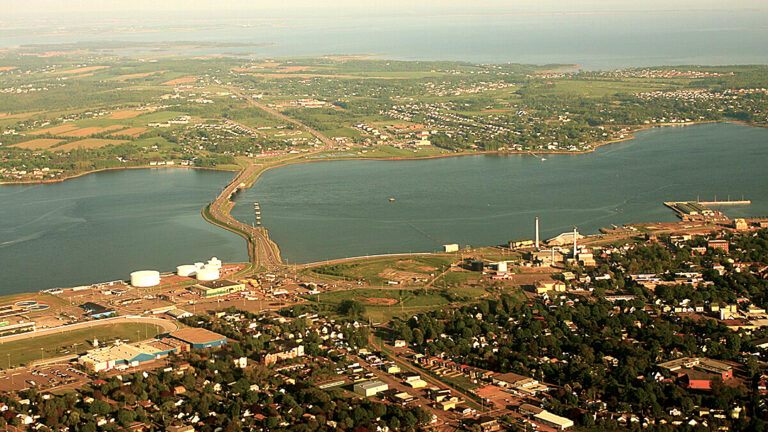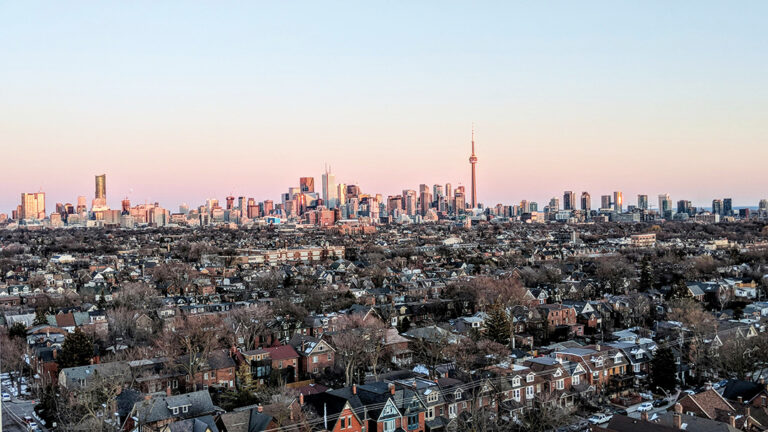From humble beginnings couch surfing and sleeping in her car, to becoming the second-youngest person to be elected to St. John’s city council, our Newfoundland and Labrador project manager has a first-hand experience of housing precarity.
How did you get interested in housing?
I spent some time in high school couch surfing and living in precarious situations. And then I went to university and things fell apart: I spent some time episodically homeless in my late teens and early twenties. That looked like various things: sleeping on people’s couches, or in my car, so housing is a very personal, intimate subject since I’ve experienced housing instability so I know how hard it is to build a life when there isn’t a stable home to pin it on.
During that time, I was doing a lot of advocacy. It was the early 2000s, it was the lead up to the Olympics so there was a lot of evictions happening. There was already a very serious homelessness issue that was exacerbated by the gentrification that came with the Olympics. We were organizing on a very grassroot level, we were running a drop-in centre where we were giving out food and safe supplies, and helping people fight their eviction the best way we knew how. It was an interesting way to get involved in housing.
How did you get involved in housing in Newfoundland and Labrador?
I was elected to my local municipal government in 2017 and took the housing lead there. And I was able to bring in some exciting new initiatives on that front. I think we have really galvanized housing as a priority in our community in a way that wasn’t before, and it’s a good shift to see happening. I think our view of “for whom” and “how” housing exists is changing, and although it’s definitely not complete, the culture around it is starting to change and people are seeing affordable housing as something the whole community should have a stake in. With COVID-19, a lot of people had the rug pulled from under them, people who thought that things were stable, only to realize that they were not. And it makes you realize that most of us are not that far from an event that could lead to losing our home.
How would you describe the rental market housing situation in Newfoundland ?
When we think of Newfoundland and Labrador, we have to think in terms of rural vs. urban. In St. John’s (urban), there are services along the housing continuum. Although there are gaps in services, for example, there is no emergency shelter that will take you if you’re a high-need client in active addiction, the services from emergency shelter to coop, or social housing exist. However, a lot of organizations are running beyond their organizational capacity because they don’t have access to adequate funding, or what they’re working with isn’t really suited to the current needs. And there are no barrier-free services for people who have a lot of complex needs.
And some social housing challenges?
Our social housing stock has been mostly built between the 1960s and the 1980s and in the 1990s at the latest. They were mostly built for families. So we’re talking about 3 or 4 bedroom units but the demand now, because of our aging population and the success of the poverty-reduction measures aimed at families, resulting in smaller families, your average person looking at supportive or affordable housing is a single adult who, if they don’t have mobility needs yet, will develop them in the next 10 to 15 years—people with complex needs age at a faster rate.
Another issue: older adults who are overhoused. They live in the social housing unit where they raised their kids but the children have moved out and they find themselves living alone in larger dwellings, with several rooms, and although this might seem like a good situation, there just isn’t an affordable alternative. So they have to pay the heating—and that can be extremely problematic.
Is heating expensive in NFL?
Heating rates are increasing rapidly, and a lot of people are living in a situation where they can’t afford their power bill. With the new hydro project coming about, the energy rates are purported to increase drastically. The arrangement in our residential tenancy acts is such that if your power gets cut off, that’s grounds for immediate eviction. Not paying your power bill can effectively make you homeless. And there is a clause saying that if you are in arrears, and you live with someone else and the power bill is in their name, they can refuse power to that person because you live there. The relationship with Newfoundland Power causes a lot of housing strife.
Can you tell us about the boom and bust economy and how it relates to housing?
Rural towns here are often driven by boom and bust economic cycles. For example, in Mary’s Town, on the southern coast of Newfoundland, there’s a shipyard there. So when the shipyard gets a big contract, rents go way, way, way up so the people who come and work in the shipyard, they make lots of money so they can afford it but it prices locals out of the market. So, if you happen to be displaced and you are looking for a new accommodation, during a boom cycle, you’re in big trouble. There’s a big challenge with the way our economy is structured, and how it relates to housing prices. That makes it very challenging for people who live in the places where these economic drivers are located.
Do you have rent control?
In NFL, we don’t have any sort of rent control legislation. So, if your landlord wants to double your rent, they can, as long as they give you a 6-month notice, and they can only put up the rent once a year. Rent control would definitely make a huge difference in rural communities that are prone to these boom and bust cycle. Unfortunately, it doesn’t seem like there’s a big appetite to address it in a meaningful way.
What do you hope to achieve in your position as project manager, specific to your region?
Increasing capacity around case management would be really important in St. John’s. There are a lot of housing units with no supports attached. And the organizations providing support have a lot of gaps in capacity, or they aren’t collaborating in a way that is most effective. I think trying to find a way to enhance service delivery, and data collection, is another thing we all know needs to be synchronized amongst community entities. Knowing who’s accessing which service, and what their journey along the housing continuum looks like can help us plan the system better. Understanding what that trajectory looks like, and what might be missing along the way, is a really important way to plan the system as a whole. I think just the fact that there is a Centre person dedicated to Newfoundland and Labrador as a resource person to service people who are looking for grants is a great start.
Hope Jamieson has 15 years of community service experience. Her interest in community housing began when she worked with refugees and continued throughout her career, working with diverse populations in St. John’s, Newfoundland and Vancouver, British Columbia. In 2017, Hope was elected to St. John’s city council, becoming the second-youngest person to be elected in this role. She was an expert on advising on affordable housing, accessibility and inclusion, and she introduced the city’s first harm reduction programs. Hope brings forth her knowledge of community mobilization—her passion—with a continued focus on creative solutions.



